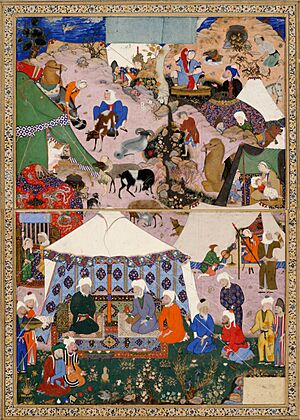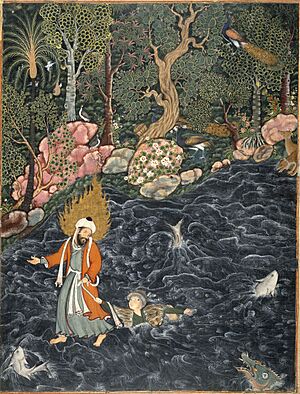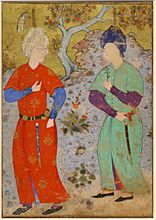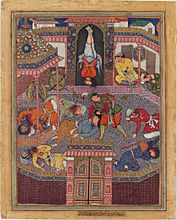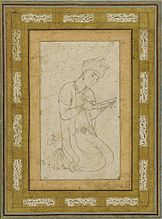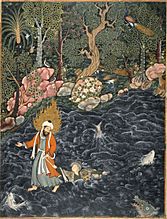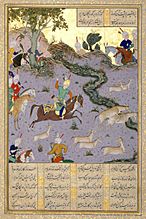Mir Sayyid Ali facts for kids
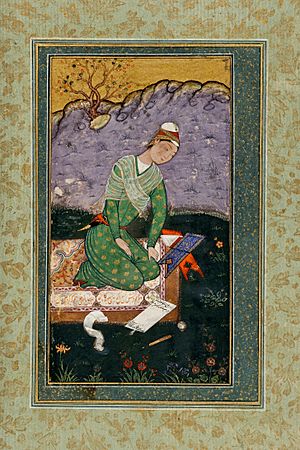
Mir Sayyid Ali (born in Tabriz, 1510 – died 1572) was a talented miniature painter from Persia. He was a top artist of Persian miniatures. Later, he worked for the Mughal dynasty in India. There, he helped create the unique style of Mughal painting under Emperor Akbar.
Contents
Who Was Mir Sayyid Ali?
Mir Sayyid Ali was born in Tabriz. His father, Mir Musavvir, was also a famous artist. A historian named Qazi Ahmed said that Mir Sayyid Ali was even more skilled than his father. However, his father's style still influenced his art.
What Were His Early Artworks Like?
Mir Sayyid Ali helped illustrate the famous Shahnameh (Book of Kings). This huge book was made between 1525 and 1548 for Shah Tahmasp I. Two of the tiny paintings in it are thought to be by Sayyid Ali.
He also worked on the beautiful Khamsa of Nizami ("Five Poems"). This book was made for Shah Tahmasp between 1539 and 1543. Out of 14 miniatures, four of them, including "Layla and Majnun", have his signature. Around 1540, he created two other important works. One was a painting of a young man holding a letter. The other was a special double painting for the Khamsa of Nizami. It showed a "nomad camp" on one side and "Evening Life Palace" on the other.
Why Did He Leave the Persian Court?
In the 1540s, Shah Tahmasp I became very strict about religion. He started to dislike paintings of living things. He lost interest in miniature art. Eventually, he made a rule that banned such images across the Persian Empire. Because of this, artists like Mir Sayyid Ali had to leave his court. Many of them found new homes at the court of Sultan Ibrahim Mirza, who was Shah Tahmasp's nephew.
Working for Emperor Humayun
Meanwhile, the Mughal Emperor Humayun lost his throne after battles with Sher Shah Suri. In 1543, Humayun went to Persia. Shah Tahmasp welcomed him warmly. While in Tabriz, Humayun met many artists and loved their work. He invited two artists to join him, hoping to create a great library of art. These artists were Abd al-Samad and Mir Musavvir. But for some reason, Mir Sayyid Ali, Mir Musavvir's son, went instead of his father.
Humayun did not get his throne back in India right away. He stayed in Kabul for a while. Mir Sayyid Ali joined him there in 1549. He lived and worked in Kabul until 1555. That year, Humayun's army won a big battle. This opened the way to Delhi, and Humayun became emperor again.
Not many of Mir Sayyid Ali's works from his time in Kabul have survived. One important piece is "Portrait of a young writer." Mir Sayyid Ali was known for his portraits. Persian portraits were often more ideal or perfect-looking. Mughal portraits, however, were more realistic. The "Portrait of a young writer" is considered one of the best Persian portraits. Experts think it might even be a self-portrait of the artist.
Working for Emperor Akbar
Emperor Humayun was followed by his son, Emperor Akbar. Akbar loved miniature portraits even more than his father. Mir Sayyid Ali and Abd al-Samad had taught Akbar drawing since he was a child. They had a close relationship.
Mir Sayyid Ali became the head of the imperial art workshop. Under his leadership, one of the biggest art projects in history began. This was the Hamzanama, a story about Amir Hamza, the uncle of the prophet Muhammad. Emperor Akbar ordered this project in 1562. Mir Sayyid Ali started leading it.
The Hamzanama was a huge project. It had 14 volumes, each with 100 illustrations. That's a total of 1,400 large miniature paintings! About 140 of these paintings still exist today in museums around the world.
Around 1572, Abd al-Samad took over the project. Mir Sayyid Ali might have been replaced because the work was going too slowly. After seven years, only four volumes were finished. Under Samad's lead, the remaining ten volumes were completed in another seven years.
The leaders of the workshop mostly oversaw the work of other artists. It's not clear if Samad painted many miniatures himself. However, one miniature, "Elijah the prophet rescues drowning Nur ad-Dahr," is credited to Mir Sayyid Ali. This painting, along with a portrait of his father and "Wise men, reflecting on the book," shows his later style.
What Is His Legacy?
Mir Sayyid Ali stayed true to the Persian art style. He worked for Akbar with artists from many places. His work showed influences from his father and Sultan Muhammad. He received many awards and much praise for his art.
Abu'l-Fazl, who was a top advisor to Emperor Akbar, wrote about him in his book History of Akbar (Akbarnama). Abu'l-Fazl spoke very highly of Mir Sayyid Ali. He listed him as one of the best artists of that time. He said, "His art he learned from his father. From the moment he got to the palace, the king's favor beam shone on him. He had distinguished himself by his art..." Emperor Humayun even gave him the special title "Nadir-ul-Mulk," which means "The Miracle of the Kingdom."
About seven years after the Hamzanama project began, around 1569, Mir Sayyid Ali left the Mughal court. As a devoted Muslim, he went on a pilgrimage to Mecca. Some researchers believe he died during this journey. Others think he returned to Akbar's court and died in 1580.
Gallery
-
A Prince and Page (c. 1540)
British Museum -
Mahiya frees Zambur, Beheads his sleeping guards, and suspends Gharrad in his stead Hamzanama
Harvard Art Museum


